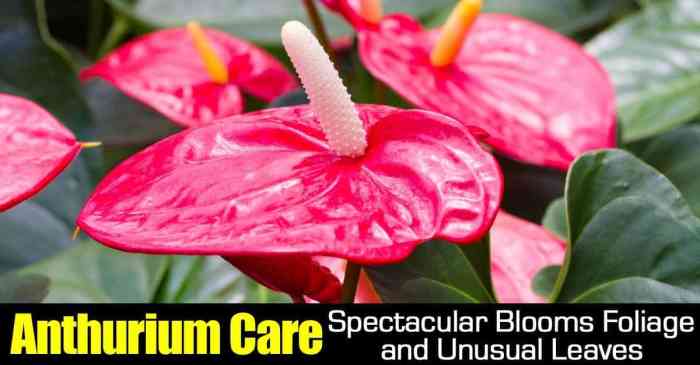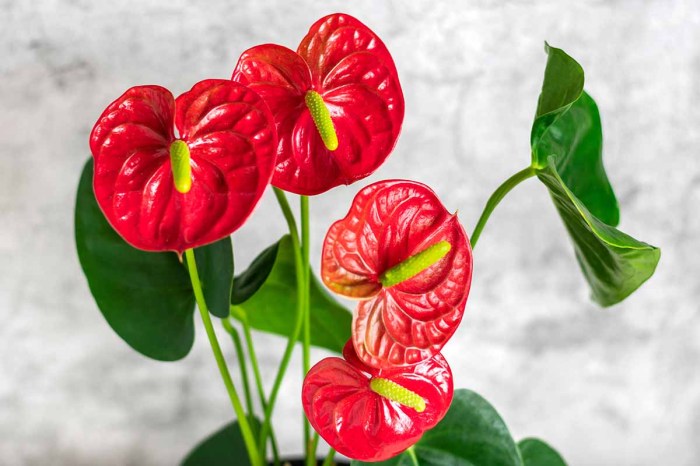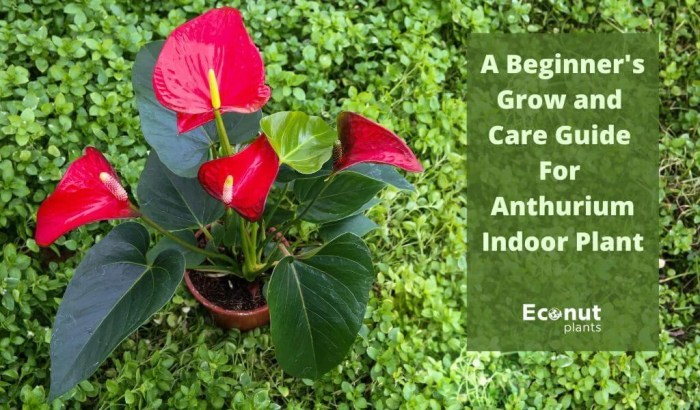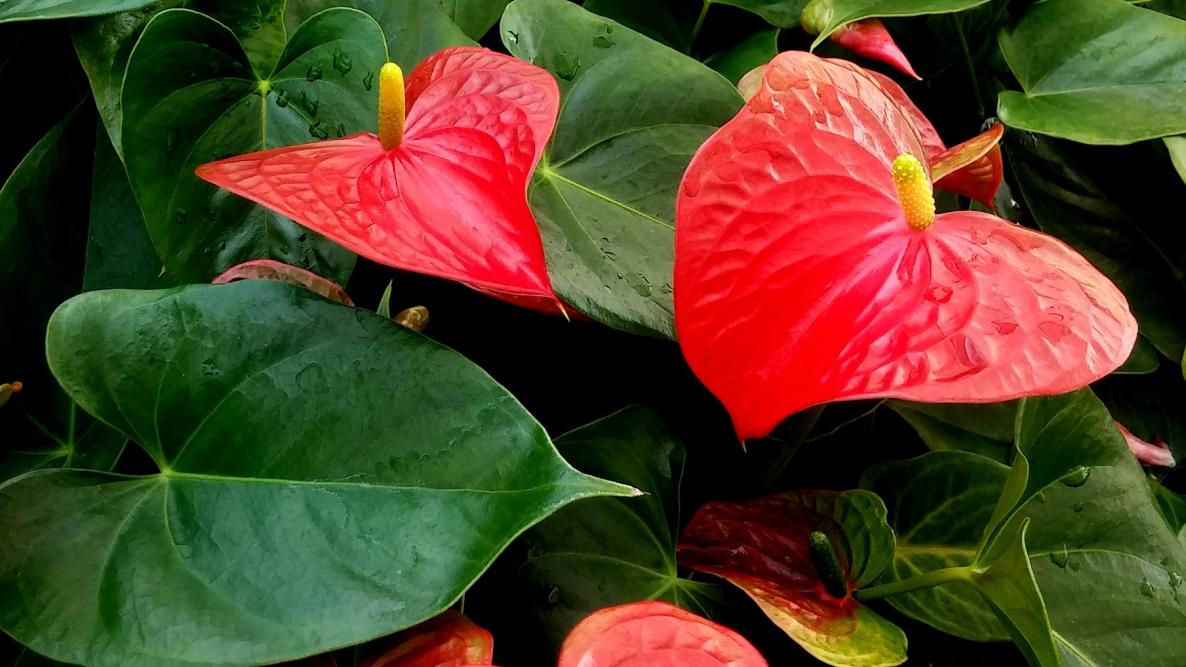How to care for anthuriums, the exotic and captivating tropical plants, is a subject that warrants meticulous attention and a profound understanding of their unique needs. In this comprehensive guide, we delve into the intricacies of anthurium care, empowering you with the knowledge to cultivate thriving and vibrant specimens that will grace your home or garden with their enduring beauty.
From optimal lighting conditions to proper watering techniques, we cover every aspect of anthurium care, ensuring that your plants flourish and bring joy for years to come.
Plant Basics and Ideal Conditions: How To Care For Anthuriums
Anthuriums, also known as flamingo flowers, are a genus of flowering plants belonging to the family Araceae. These tropical perennials are native to the rainforests of Central and South America. They are prized for their striking, heart-shaped spathes, which come in a wide range of colors, including red, pink, white, and purple.
Anthuriums are relatively easy to care for, but they do have some specific requirements. They prefer bright, indirect light, warm temperatures, and high humidity. The ideal temperature range for anthuriums is between 65 and 85 degrees Fahrenheit (18 to 29 degrees Celsius).
They also need high humidity, around 70 to 80%. If the humidity is too low, the leaves of the plant will start to brown and curl.
Lighting
Anthuriums prefer bright, indirect light. They can tolerate some direct sunlight, but too much direct sunlight can scorch the leaves. The best place to place an anthurium is in a window that receives morning or afternoon sun.
Temperature
Anthuriums prefer warm temperatures. The ideal temperature range for anthuriums is between 65 and 85 degrees Fahrenheit (18 to 29 degrees Celsius). If the temperature drops below 60 degrees Fahrenheit (15 degrees Celsius), the plant may go dormant.
Humidity
Anthuriums need high humidity. The ideal humidity range for anthuriums is between 70 and 80%. If the humidity is too low, the leaves of the plant will start to brown and curl. You can increase the humidity around your anthurium by placing it on a tray of pebbles filled with water.
The water will evaporate and create a humid environment for the plant.
Watering and Fertilizing

Anthuriums thrive with proper hydration and nutrition. Watering and fertilizing play crucial roles in maintaining their health and vibrant blooms.
Watering
Anthuriums prefer moist but not soggy soil. Overwatering can lead to root rot, while underwatering causes wilting and stunted growth. Allow the top 2-3 inches of soil to dry out before watering thoroughly. During the growing season, water more frequently, reducing watering during the dormant period.
For those with green thumbs seeking to nurture their anthuriums, maintaining optimal soil conditions is paramount. Consider using Bunnings Orchid Soil , a specialized blend designed to provide the ideal balance of nutrients and drainage for your anthuriums to thrive.
Its unique composition, as outlined in the comprehensive guide, ensures proper root development and supports overall plant health.
Use room-temperature water and avoid getting water on the leaves.
Fertilizing
Anthuriums benefit from regular fertilization. Use a balanced liquid fertilizer diluted to half strength and apply it every 2-3 weeks during the growing season. During the dormant period, fertilize less frequently, about once a month. Choose a fertilizer rich in nitrogen, phosphorus, and potassium (NPK) for optimal growth and flowering.
Soil and Potting

Anthuriums thrive in a well-draining potting mix that is rich in organic matter. The ideal pH range for anthuriums is between 5.5 and 6.5. A mixture of peat moss, perlite, and orchid bark is a good option.
Pot Size and Material
Choose a pot that is large enough to accommodate the plant’s roots, but not so large that the soil stays wet for too long. The pot should have drainage holes to prevent waterlogging.
When it comes to caring for anthuriums, ensuring they receive adequate sunlight and well-drained soil is paramount. If you’re looking for ways to elevate your indoor décor while providing a suitable environment for your anthuriums, consider exploring the wide selection of hanging plants bunnings offers.
These hanging planters not only add a touch of elegance but also allow for optimal airflow and light distribution, fostering healthy growth for your anthuriums.
Terracotta or clay pots are a good choice for anthuriums because they allow the soil to breathe and prevent waterlogging.
When caring for anthuriums, it’s important to provide them with well-draining soil and bright, indirect light. For optimal growth, consider using Bunnings Outdoor Ceramic Pots , which offer excellent drainage and a stylish aesthetic. The comprehensive guide on this website provides valuable tips on styling, planting, and caring for plants in these pots, ensuring the health and beauty of your anthuriums.
Pruning and Propagation
Pruning anthuriums promotes healthy growth and improves aesthetics by removing dead or diseased foliage and encouraging new growth. Pruning also controls the size and shape of the plant, making it suitable for various spaces.
Pruning Techniques, How to care for anthuriums
- Remove dead or damaged leaves by cutting them at the base of the stem using sharp, clean shears.
- Trim overgrown stems to encourage branching and bushier growth. Cut stems just above a leaf node, the point where a new leaf or branch emerges.
- Remove faded or spent flowers to prevent seed production, which can weaken the plant.
Propagation
Propagating anthuriums is a rewarding way to expand your collection or share these beautiful plants with others. Two common methods are stem cuttings and division.
Stem Cuttings
- Select a healthy stem with at least two leaves.
- Cut the stem below a leaf node using a sharp knife or shears.
- Remove the lower leaves, leaving only the top two or three.
- Dip the cut end of the stem in rooting hormone (optional but recommended).
- Plant the cutting in a well-draining potting mix and keep it moist.
- Provide bright, indirect light and keep the cutting warm until new roots develop.
Division
- Carefully remove the anthurium from its pot.
- Gently separate the roots into two or more sections, ensuring each section has healthy roots and at least one growing point.
- Replant the divisions in individual pots with fresh potting mix.
- Water the plants thoroughly and place them in a warm, humid location.
Troubleshooting Common Issues

Anthuriums are generally resilient plants, but they can encounter various pests and diseases. Proper care and early intervention are crucial to maintain their health and prevent severe damage.
To maintain the lush foliage of anthuriums, provide bright, indirect light, water when the top inch of soil feels dry, and fertilize monthly with a balanced fertilizer. For an elegant display, consider placing your anthuriums in one of Bunnings’ versatile plant baskets . These baskets come in a variety of styles and materials, making them a stylish and practical solution for any indoor space.
When caring for anthuriums in hanging baskets, ensure the soil drains well to prevent root rot.
Pests
- Aphids:Tiny, soft-bodied insects that suck sap from leaves and stems, causing yellowing and stunted growth.
- Mealybugs:Small, white, cottony insects that infest leaves and stems, secreting a sticky substance that attracts ants and promotes fungal growth.
- Spider mites:Microscopic pests that create fine webbing on leaves, causing yellowing and stippling.
Diseases
- Anthracnose:Fungal disease that causes brown spots on leaves and stems, leading to wilting and defoliation.
- Bacterial blight:Bacterial infection that causes water-soaked lesions on leaves and stems, leading to rapid wilting and death.
- Root rot:Fungal disease that affects the roots, causing them to rot and the plant to wilt and die.
Last Point

By following the expert advice Artikeld in this guide, you can create an environment that meets the specific requirements of your anthuriums, allowing them to thrive and showcase their stunning blooms. With patience, dedication, and a touch of green-thumb magic, you can transform your space into a tropical oasis where these exotic beauties flourish.
Frequently Asked Questions
How often should I water my anthurium?
Water your anthurium when the top inch of soil feels dry to the touch. Avoid overwatering, as this can lead to root rot.
What type of fertilizer should I use for my anthurium?
Use a balanced liquid fertilizer diluted to half strength every two weeks during the growing season.
How can I propagate my anthurium?
Anthuriums can be propagated through stem cuttings or division. Take a cutting from a healthy stem and place it in a pot with well-draining soil. Keep the soil moist and provide bright, indirect light.